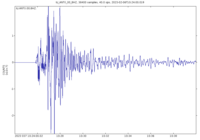2023 Turkey–Syria earthquake facts for kids

Clockwise from top left: Rescue efforts in Hama, Syria; Adıyaman; damaged Gaziantep Castle; Diyarbakır; Hatay; Hatay
|
|
| UTC time | 2023-02-06 01:17:35 |
|---|---|
| ISC event | 625613033 |
| USGS-ANSS | ComCat |
| Local date | 6 February 2023 |
| Local time | 04:17 TRT (UTC+3) |
| Duration | 80 seconds |
| Magnitude | Mww 7.8 |
| Depth | 10.0 km (6 mi) |
| Epicenter | Şehitkamil, Gaziantep 37°09′58″N 37°01′55″E / 37.166°N 37.032°E |
| Fault | Dead Sea Transform, East Anatolian Fault, Çardak–Sürgü Fault |
| Type | Strike-slip |
| Areas affected | Turkey and Syria |
| Total damage | US$84.1 billion (estimated) |
| Max. intensity | XI (Extreme) |
| Peak acceleration | 1.62 g |
| Tsunami | 17 cm (6.7 in) |
| Aftershocks | 2,109 (by 12 February) 340+ with a Mw 4.0 or greater Largest: Mw7.7 at 13:24 TRT (UTC+3), 6 February 2023 |
| Casualties | > 51,130 deaths, 122,500 injured
|
On February 6, 2023, a very strong earthquake hit southern and central Turkey and northern and western Syria. It happened at 4:17 AM local time. The main earthquake had a strength of 7.8 on the magnitude scale. Its center, called the epicenter, was near the city of Gaziantep.
This powerful earthquake was followed by another strong one, measuring 7.7 magnitude, later the same day. This second quake was centered about 95 kilometers north of the first one. Both earthquakes caused widespread damage and led to the deaths of tens of thousands of people.
The 7.8 magnitude earthquake was the strongest to hit Turkey since 1939. It was also one of the most powerful earthquakes ever recorded in the region. People felt the shaking as far away as Egypt, Israel, and Cyprus. More than 2,100 smaller earthquakes, called aftershocks, followed the main quakes. These earthquakes happened because of sudden movements along cracks in the Earth's crust called strike-slip faults.
The earthquakes affected a huge area, about 350,000 square kilometers. This is about 14 million people, or 16 percent of Turkey's population. Experts from the United Nations estimated that about 1.5 million people lost their homes.
By February 26, 2023, over 51,100 deaths were confirmed. More than 44,300 deaths were in Turkey, and over 6,700 were in Syria. This makes it the deadliest earthquake in Turkey since 526 AD and the deadliest in Syria since 1822. Globally, it was the deadliest earthquake since the 2010 Haiti earthquake. The total damage from these earthquakes is estimated to be around US$84.1 billion. This makes them among the most expensive earthquakes ever recorded. It is also the deadliest natural disaster in Turkey's modern history.
Damaged roads, winter storms, and broken communication lines made rescue efforts very difficult. Turkey's disaster agency, AFAD, led the rescue work. They had a team of 60,000 search-and-rescue workers, 5,000 health workers, and 30,000 volunteers. Many countries also sent help. More than 141,000 people from 94 countries joined the rescue effort.
Contents
Understanding the Earthquakes
The Main Shakes
The first big earthquake hit at 1:17 AM UTC. Its center was about 34 kilometers west of Gaziantep city, close to the border with Syria. This earthquake was as strong as the 1939 Erzincan earthquake, making it the strongest ever recorded in Turkey. It was also one of the largest earthquakes recorded anywhere in the world since August 2021.
How Many People Were Affected?
A professor who studies earthquakes at the Kandilli Observatory thought the number of deaths could be similar to the 1999 İzmit earthquake, where 18,373 people died. On February 6, when over 3,400 deaths were reported, the World Health Organization warned that the final number could be much higher.
The earthquakes also affected Turkey's economy. The value of the Turkish lira currency dropped to a very low point. Stock markets in Turkey also fell, but they later started to recover.
Tsunami Warnings
Small tsunami waves were seen off the coast of Famagusta, Cyprus. Luckily, these waves did not cause any damage.
Italy's Civil Protection Department also issued a warning for possible tsunami waves. They thought waves might hit the coasts of Sicily, Calabria, and Apulia. People living in these areas were told to go to higher ground. Train services in these regions were stopped for a short time but started again later that morning.
Life After the Quakes
Turkish officials reported that more than 5,600 buildings were destroyed. This included a state hospital in the city of Iskenderun. Tens of thousands of people in Turkey and Syria lost their homes. They had to spend the night outside in very cold weather.
Many mosques in Turkey were used as shelters for people who could not go back to their homes. In Gaziantep, people found safety in shopping malls, sports stadiums, community centers, and mosques.
Images for kids
-
Wreckage of the collapsed Galeria Business Center, Diyarbakır
See also
 In Spanish: Terremotos de Turquía y Siria de 2023 para niños
In Spanish: Terremotos de Turquía y Siria de 2023 para niños























